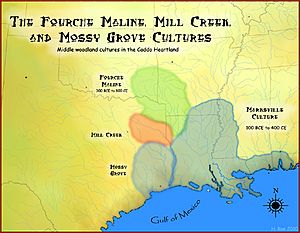Fourche Maline culture facts for kids
The Fourche Maline culture (say it: foosh-ma-lean) was a group of Native American people who lived a long time ago. They were part of the Woodland period in North America. This culture existed from about 300 years before Christ (BCE) to 800 years after Christ (CE). That's over a thousand years!
These people lived in what is now southeastern Oklahoma, southwestern Arkansas, northwestern Louisiana, and northeastern Texas. They are thought to be ancestors of the Caddoan Mississippian culture, along with the Mill Creek culture from eastern Texas. The Fourche Maline culture got its name from the Fourche Maline Creek, a stream in Oklahoma. Today, their descendants are the Caddo Nation of Oklahoma.
Contents
Who Were the Fourche Maline People?
In the late 1930s, archaeologists (scientists who study old cultures) found many interesting things. They were working in the Wister Valley in southeastern Oklahoma. They found very thick, dark layers of soil filled with old tools and pottery. These layers were like ancient trash heaps, and people called them "black mounds."
These sites showed a mix of items from different time periods: the Archaic, Woodland period, and Mississippian culture. These discoveries helped scientists understand the Fourche Maline culture.
Around this time, people in the area started using ceramic pottery. They likely learned this from the Tchefuncte culture peoples who lived to the southeast. The Fourche Maline people began to settle down more. They started living in semi-permanent villages and growing their own food. They planted crops like maize (corn) and other plants from the Eastern Agricultural Complex.
Growing and Trading
As the population grew, the Fourche Maline people started trading more with other groups. Trading with people from the southwest brought them the bow and arrow. They also traded with the Marksville culture and other Hopewellian peoples. This trade brought exciting items from far away. They got freshwater pearls, seashells, sharks' teeth from the Gulf Coast, and copper from northern areas.
During this period, the Fourche Maline society also began to change. Some people started to have more power and importance. Researchers are still studying if this change happened on its own or if it was influenced by the Hopewell culture.
The way they buried their dead also became more special. They started building the first burial mounds. These were special earth mounds for burying people. Leaders also began to gain more power. They organized the building of the first earthwork platform mounds. These mounds were used for important ceremonies and sometimes as homes for the leaders.
Life and Challenges
Archaeological digs at the McCutcheon-McLaughlin site in Oklahoma taught us a lot about the Fourche Maline people. They were healthier when they ate nuts, seeds, tubers, fish, and game. This was during their hunting and gathering time. Their descendants, who ate more corn, were not as healthy. Also, diseases like arthritis were less common among the Fourche Maline people.
However, their lives were still tough. A common cause of death found in their burials was warfare. Scientists found several mass graves. The bodies had injuries from projectile points (arrowheads or spear points). One grave held nine bodies, mostly women and children. They were attacked with a type of stone point not found in their area. This suggests a raiding party from another region might have attacked them when their warriors were away. The people who survived buried their dead together in one large grave.
It's not fully known if these people lived in one place all the time or moved around. But they definitely had a big impact on the people who lived later in the Arkansas and Red River Valleys, and all over eastern Oklahoma.
Fourche Maline Pottery
Fourche Maline pottery was made by adding materials like grog (crushed pottery), bone, grit, and sand to the clay. It is believed that women made this pottery. It's known for its unique shape: often flat-based vessels with thick walls, much like a modern flower pot. Some common types of pottery found at their old sites are Williams plain, Cooper Boneware, and Ouachita plain.



